The Health Ministry hopes that a modern pharmaceutical warehouse commissioned yesterday at Diamond on the East Bank of Demerara would help reduce the amount of expired drugs being dumped each year.
Named the ‘Ministry of Health Supply Chain Management Complex,’ Health Minister Dr. Bheri Ramsaran said the 20,000 square meter facility, located on 1st Street, New Diamond Housing Scheme, would go a long way to address concerns that have been raised in a number of Auditor General’s reports.
Big losses were suffered by the Ministry of Health due to the expiration of large quantities of drugs, the 2010 report of the Auditor General had stated.
The Ministry of Health, it had said, continued to suffer losses due to expiration of large quantities of drugs. Noteworthy was the fact that destruction of expired drugs valued at $39.955M had occurred for the period under review and that there was a large quantity of expired stock still on hand pending processing and destruction. This has been a longstanding problem at state warehouses.

“We have discovered or (it has been) uncovered by the Auditor General in his annual report reports … significant losses to the system due to expiring drugs. We have been genuinely grappling with this over the years and that is why in the first place we conceptualized this project… this facility now can allow us to cut away at the cost of expired drugs,” said Ramsaran of the facility which had been under construction since 2009.
The Health Minister stated that the reduction of dumping of drugs would be transformational in ensuring an “economy of savings.” In addition, he noted that it would have a fully computerized system of invoicing, hence eliminating the manual inventory.
Ramsaran pledged to manage the approximately $500M complex in keeping with the Standard Operating Procedures that have been crafted.
The United States Global AIDS Coordinator, Ambassador Eric Goosby, who could not attend the commissioning ceremony, sent remarks which were read by the Supply Chain Management System (SCMS) Divisional Head Sherif Mowafy. He said that PEPFAR (President’s Emergency Plan for AIDS Relief) , the Global Fund and the World Bank, some of the donors to the facility, were committed to improving collaboration and coordination on supply chain management of HIV/AIDS pharmaceuticals.
“The Government of Guyana provides a strong example of how coordinated, country-led HIV/AIDS planning and programming can make all the difference. We have also benefitted greatly from the Supply Chain Management System project, which has increased the number of trained pharmacists and supply chain workers, strengthened procurement, and improved warehousing and distribution operations in the country,” he said.
“As we work together to ensure sustainability, we are increasingly reliant on our partner countries to play the central orchestration role in their HIV/AIDS responses—and we stand ready to support you in these efforts,” he added.
According to Goosby the warehouse supply chain is a significant step toward building a world class pharmaceutical-grade operation and by extension a path to creating an AIDS-free generation here and worldwide as all partners give their due. “The next step is to ensure that Guyana’s Materials Management Unit fully absorbs the capacity built through the U.S. government’s technical support, while the Government of Guyana focuses on managerial and financial oversight,” his statement read.
PEPFAR committed to sharing technical and managerial expertise so that the ministry could now guide operations of the complex.
United States Ambassador Brendt Hardt focused on scaling up Combination Prevention and Treatment as part of efforts to be smart about US investments in this sector.
“We will be smart about our investments- going where the virus is, and targeting evidence-based interventions for populations at greatest risk. Understanding how the virus moves through a population is directly informed by understanding where new infections are occurring,” said Hardt.
Calling the complex a vital stepping stone on the road to ensuring that Guyana’s pharmaceutical management operations are world class, Hardt said, “This project we are dedicating here today embodies the goal of making smarter investments and supporting interventions that optimize the targeting of illness. This new warehouse will significantly improve Guyana’s storage and distribution capacity for HIV-related products and the essential drugs by housing all the medicines under one roof and in the best conditions.”
The complex is the result of partnerships with the United States, that country’s PEPFAR, The Global Fund, The World Bank and the Inter-American Development Bank.
Reporters were informed that the facility has built-in temperature-controlled rooms to ensure that medicines do not expire prematurely. It will make use of efficient and modern inventory systems to prevent spoilage and facilitate timely acquisition of needed medicines, while ensuring that Guyana’s population has access to pharmaceutical products of the highest quality.





